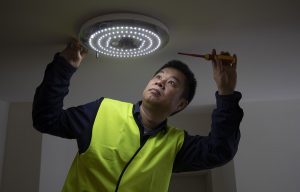WBS rolls out EMIoT building management platform
Australian lighting solutions provider WBS Technology is rolling out technology across the country that allows buildings to monitor themselves and report problems autonomously.
Known as EMIoT, the new wireless platform was developed by UNSW and relies on LED exit signs as the backbone of a low-power meshed network that covers 99.9% of a building – even reaching underground car parks, pump systems and air conditioning.
“All you need is to install the emergency lights and they all automatically connect to each other, and that creates the network,” says UNSW School of Computer Science and Engineering senior lecturer Dr Wen Hu.
ADVERTISEMENT
“The emergency lights can then be networked with other devices via various wireless technologies, including Bluetooth, which allows them to be controlled locally with a smart phone or via the internet from anywhere in the world.”
Remote control
EMIoT allows each exit sign or emergency light acts as a node in the network, passing information back and forth across a building.
Once operating, other devices can be connected to the network – ventilation and pumping systems, security cameras and sensors, access doors to common areas and halls – allowing all of them to be controlled and monitored remotely.
Sensors as a service
WBS uses EMIoT technology to offer ‘sensors as a service’. For a fixed monthly fee, WBS provides a network of emergency and other lights that monitor themselves, react to their surroundings and to remote commands, and can have other devices added to the same network.
As the network expands, energy usage and the status of heating and cooling could be tracked, flow gauges report back on water usage and identify leaks, ventilation and pumping systems monitored remotely, and hot water systems checked for faults.
Smart building ecosystem
“We’re actually creating a smart building ecosystem,” says WBS Technology marketing coordinator Luke Gibbeson.
“Our communications gateway looks like a standard exit sign, which relays other emergency lights communication to the cloud and acts like a normal exit sign – so it’s a plug and play system. You can install in a new building or retrofit into an older one, like this one,” he adds.
“As more IoT devices are installed, they can be added to the network, and all managed remotely via a cloud-based service, or locally through a smart phone app.”
-
ADVERTISEMENT
-
ADVERTISEMENT


